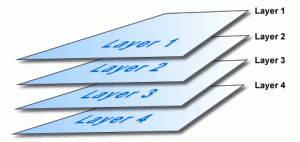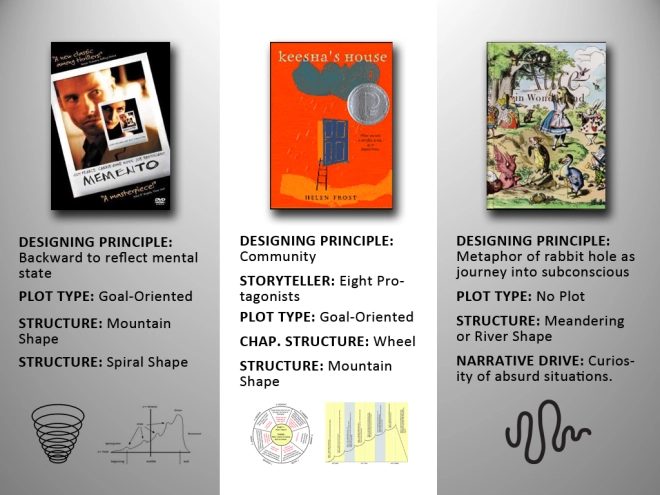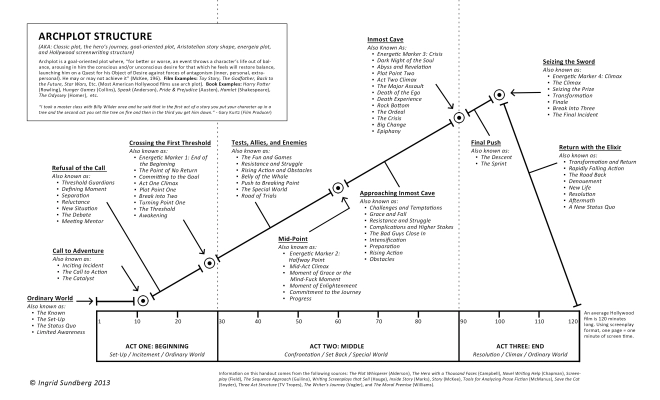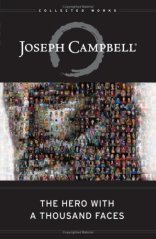new posts in all blogs
Viewing: Blog Posts Tagged with: Goal Oriented Plot, Most Recent at Top [Help]
Results 1 - 4 of 4
How to use this Page
You are viewing the most recent posts tagged with the words: Goal Oriented Plot in the JacketFlap blog reader. What is a tag? Think of a tag as a keyword or category label. Tags can both help you find posts on JacketFlap.com as well as provide an easy way for you to "remember" and classify posts for later recall. Try adding a tag yourself by clicking "Add a tag" below a post's header. Scroll down through the list of Recent Posts in the left column and click on a post title that sounds interesting. You can view all posts from a specific blog by clicking the Blog name in the right column, or you can click a 'More Posts from this Blog' link in any individual post.

By: Ingrid Sundberg,
on 8/5/2013
Blog:
Ingrid's Notes
(
Login to Add to MyJacketFlap)
JacketFlap tags:
Plot,
Writing Craft,
Structure,
Story Structure,
Story Design,
Organic Architecture,
Classic Design,
Goal Oriented Plot,
Designing Principle,
Mountain Structure,
Add a tag
 I’ve spent the last two months talking all about classical design, alternative structures and plots, and designing principles! Hopefully you’ve seen that there are innumerable design possibilities at your fingertips. But as I walked us through this series, I’m sure a few of you read my posts and thought to yourself: Doesn’t that story fit into multiple types of structure? For example, as I explained that The Godfather uses a fairy-tale structure, you might have been thinking: But Ingrid, it also uses the mountain structure!
I’ve spent the last two months talking all about classical design, alternative structures and plots, and designing principles! Hopefully you’ve seen that there are innumerable design possibilities at your fingertips. But as I walked us through this series, I’m sure a few of you read my posts and thought to yourself: Doesn’t that story fit into multiple types of structure? For example, as I explained that The Godfather uses a fairy-tale structure, you might have been thinking: But Ingrid, it also uses the mountain structure!
To which I’d say: You’re right!
Which brings me to my final point in this series: design and structure are layered. You won’t necessarily pick on design concept and be done.
In the film Memento, the designing principle uses a backwards structure to reflect short term memory. But it also has a goal-oriented plot and a mountain structure. Only the major structural beats are flipped. If the story was told forward, what would be considered the inciting incident becomes the climax when it’s told backwards. Additionally, because the story revisits events of the past, again and again, you could also consider this movie to have a spiral structure.
Helen Frost’s novel Keesha’s House is also layered. It’s told with eight protagonists as a portrait of a community and each chapter uses a wheel structure to unify the characters through a theme. But the structure of the whole novel still uses a mountain escalation as each chapter introduces new obstacles. It’s also a goal-oriented plot: to find a safe place to live.

Stories are layered. And you may find, like me, that the story you’re trying to tell doesn’t fit easily into a three act structure or the hero’s journey. Or maybe it does. And it’s okay if it does. Just make sure that’s a choice you’ve made because it’s right for your story.
Screenwriter Charlie Kaufman said in a lecture to the British Film Academy that “there’s no template for a screenplay, or there shouldn’t be. There are at least as many screenplay possibilities as there are people who write them. Don’t let anyone tell you what a story is, what it needs to include or what form it must take.”
Only you know how to tell your story and only you know how to design it.
Thanks for reading this series!



By: Ingrid Sundberg,
on 8/5/2013
Blog:
Ingrid's Notes
(
Login to Add to MyJacketFlap)
JacketFlap tags:
Plot,
Writing Craft,
Structure,
Story Structure,
Story Design,
Organic Architecture,
Classic Design,
Goal Oriented Plot,
Designing Principle,
Mountain Structure,
Add a tag
 I’ve spent the last two months talking all about classical design, alternative structures and plots, and designing principles! Hopefully you’ve seen that there are innumerable design possibilities at your fingertips. But as I walked us through this series, I’m sure a few of you read my posts and thought to yourself: Doesn’t that story fit into multiple types of structure? For example, as I explained that The Godfather uses a fairy-tale structure, you might have been thinking: But Ingrid, it also uses the mountain structure!
I’ve spent the last two months talking all about classical design, alternative structures and plots, and designing principles! Hopefully you’ve seen that there are innumerable design possibilities at your fingertips. But as I walked us through this series, I’m sure a few of you read my posts and thought to yourself: Doesn’t that story fit into multiple types of structure? For example, as I explained that The Godfather uses a fairy-tale structure, you might have been thinking: But Ingrid, it also uses the mountain structure!
To which I’d say: You’re right!
Which brings me to my final point in this series: design and structure are layered. You won’t necessarily pick on design concept and be done.
In the film Memento, the designing principle uses a backwards structure to reflect short term memory. But it also has a goal-oriented plot and a mountain structure. Only the major structural beats are flipped. If the story was told forward, what would be considered the inciting incident becomes the climax when it’s told backwards. Additionally, because the story revisits events of the past, again and again, you could also consider this movie to have a spiral structure.
Helen Frost’s novel Keesha’s House is also layered. It’s told with eight protagonists as a portrait of a community and each chapter uses a wheel structure to unify the characters through a theme. But the structure of the whole novel still uses a mountain escalation as each chapter introduces new obstacles. It’s also a goal-oriented plot: to find a safe place to live.

Stories are layered. And you may find, like me, that the story you’re trying to tell doesn’t fit easily into a three act structure or the hero’s journey. Or maybe it does. And it’s okay if it does. Just make sure that’s a choice you’ve made because it’s right for your story.
Screenwriter Charlie Kaufman said in a lecture to the British Film Academy that “there’s no template for a screenplay, or there shouldn’t be. There are at least as many screenplay possibilities as there are people who write them. Don’t let anyone tell you what a story is, what it needs to include or what form it must take.”
Only you know how to tell your story and only you know how to design it.
Thanks for reading this series!



By: Ingrid Sundberg,
on 6/12/2013
Blog:
Ingrid's Notes
(
Login to Add to MyJacketFlap)
JacketFlap tags:
Plot,
Writing Craft,
Story Structure,
The Hero's Journey,
The Universal Story,
Energic Plot,
Classic Plot,
Classic Design,
Goal Oriented Plot,
Mythic Structure,
Add a tag
 From my previous posts outlining the major beats of classic design (aka: arch plot, the universal story, mythic structure, the hero’s journey, etc.) you’ve seen that this design is very precise. If done well this “universal story” creates a satisfying story experience where all the pieces seem to fall effortlessly into place. It’s clean. It’s inspiring. It’s tempting to use such a beautiful template to organize our stories as well. And at first glance – why shouldn’t we? After all classic design is touted as:
From my previous posts outlining the major beats of classic design (aka: arch plot, the universal story, mythic structure, the hero’s journey, etc.) you’ve seen that this design is very precise. If done well this “universal story” creates a satisfying story experience where all the pieces seem to fall effortlessly into place. It’s clean. It’s inspiring. It’s tempting to use such a beautiful template to organize our stories as well. And at first glance – why shouldn’t we? After all classic design is touted as:
“… the story of life. Since before time was recorded, it has been transforming simple words into masterpieces … [it] is the undercurrent of every breath you take, every story you tell yourself, and all the stories you write.” –Martha Alderson (The Plot Whisperer)
“Aristotle’s story structure works, and in fact it is the only structure that has ever worked, because it is a mirror of our own views on the universe.” — Lisa Doan (Plot Structure)
 In his book Story, Robert McKee has the grace to acknowledge other plots, but goes on to point out that a writer must earn a living at writing, and according to him you can’t do that without arch plot because “classical design is a mirror of the human mind.”
In his book Story, Robert McKee has the grace to acknowledge other plots, but goes on to point out that a writer must earn a living at writing, and according to him you can’t do that without arch plot because “classical design is a mirror of the human mind.”
With these kinds of endorsements why would you ever consider an alternate story structure?
Vermont College of Fine Arts faculty member Shelley Tanaka posed the following question in one of her lectures:
“Is there such a thing as a universal child?”
I’m sure you know the answer to that question. So how can there possibly be such a thing as a universal story? How can there only be one story of life, one view of the universe, or one mirror of the human mind? Katie Bayerl notes in her graduate thesis that “a single narrative structure, no matter how flexible, can’t possibly address the diverse needs of readers.”
And yet we are constantly encouraged to use this one form of design.
In Anatomy of Story, John Truby points out that “one of the great principals of storytelling is that structure doesn’t just carry content; it is content.” And McKee says that: “Our appetite for story is a reflection of [our] … need to grasp the patterns of living … Fiction [is] a vehicle that carries us on our search for reality … story is a metaphor for life … [it] gives life its form.” So, if we seek story as a guide for how to live our lives, and if structure is the content that reveals that guide, then we ought to consider what this one universal story has to say.
Katie Bayerl notes that the hero’s journey plot is “comforting in its familiarity and in its emphasis on an individual’s ability to triumph over adversity … it is the dominant American narrative of progress and individualism. For writer’s who don’t question those belief systems the hero’s journey may feel like the best way to tell a good story. For those with an agenda of empowerment, it may appear like the only option.”
 And for Joeseph Campbell (the founder of mythic structure), it turns out he may have had an agenda of empowerment. Bayerl notes that he “became obsessed with the hero’s journey because he was troubled by what he perceived as the despair of his times; he believed that elevating heroic myths would heal the collective psyche. Campbell explains how the hero myth can support healthy psychological growth when people recognize their own problems in the ordeals of the mythic … and are reassured by the stories that give them abundant, time-tested strategies for survival, success, and happiness.” This is exactly what Truby and McKee meant when they said structure can be used as a metaphor for how to live our lives.
And for Joeseph Campbell (the founder of mythic structure), it turns out he may have had an agenda of empowerment. Bayerl notes that he “became obsessed with the hero’s journey because he was troubled by what he perceived as the despair of his times; he believed that elevating heroic myths would heal the collective psyche. Campbell explains how the hero myth can support healthy psychological growth when people recognize their own problems in the ordeals of the mythic … and are reassured by the stories that give them abundant, time-tested strategies for survival, success, and happiness.” This is exactly what Truby and McKee meant when they said structure can be used as a metaphor for how to live our lives.
But what are the psychological implications of this structure?
1) Are Our Lives Defined by Lack of Desire?
By creating a story design that is driven by goals and desires, are we saying this is the only way in which to define our worth and success? Bayerl asks: “Does it mean our lives must always be defined by lack of desire? Are we failures if we cannot independently solve every problem that faces us? Must we all be heroes?”
 2) Does it Create a False Sense of Values?
2) Does it Create a False Sense of Values?
When a plot is goal-oriented and revolves around achieving a task (getting the girl, saving the world, winning the race, etc.) does it create a false sense of values? Instead of searching for wisdom, do we put value in the search for an external goal only to find ourselves disappointed?
3) Does it Limit Our Vision to Only One Aspect of Existence?
Diane Lefer quotes Ursula Le Guin in questioning if this structure isn’t a rather “gladiatorial view of fiction” one where we’re “… taught to focus our stories on a central struggle, [and] … by default base all our plots on the clash of opposing forces. We limit our vision to a single aspect of existence and overlook much of the richness and complexity of our lives, just the stuff that makes a work of fiction memorable.”
4) Is it Socially Coercive?
Young adult author Amy Rose Capetta’s lecture on catharsis discusses how a pleasurable catharsis can be the result of Aristotelian structure, but she goes on to introduce Augusto Boal’s opinions on the matter, wherein he suggests that this type of catharsis is socially coercive. Capetta explains that “Boal was convinced that catharsis as it was presented by Aristotle, was not just normative in that it returned the audience to their default emotional state, but that in fact it served a socially normative function, reinforcing and upholding the status quo.”
 5) Does it Perpetuate an Untrue American Myth?
5) Does it Perpetuate an Untrue American Myth?
And lastly, Malcolm Gladwell’s non-fiction book Outliers, has pretty much de-bunked the modern American myth that if you set yourself out a goal, and you try hard enough to overcome the obstacles, you’ll succeed. This simply isn’t true. So why do we continually write stories about hero’s overcoming obstacles and succeeding in the end as if it is the natural order of things?
Is it possible that the hero’s journey myth, is just that – a myth. After all, it does initially derive from stories of mythology, and not actual experiences. Not to mention that the popularization of this design is relatively new. Yes, it shows up in ancient works and the classics of western literature. But it’s elevation as the end-all be-all of storytelling started in the 1950’s with Campbell’s research and was greatly escalated by the influence Star Wars on American film. Is it possible that arch plot and mythic structure are the predominant storytelling paradigm of our time and not a universal story?
Am I saying that we shouldn’t use this storytelling plot and structure?
No.
But I think you should ask yourself why you’re using it, and not use it blindly because there’s an implication that it’s the only type of design that exists.
Don’t fret! The coming posts will introduce you to the wide variety of plots and structures that will take you beyond arch plot and mythic structure. Stay tuned and see how many options really are available to you!
WORKS CITED:
Alderson, Martha. The Plot Whisperer: Secrets of Story Structure Any Writer Can Master. New York: Adams Media, 2011.
Bayerl, Katie. “Must We All Be Heroes? Crafting Alternatives to the Hero’s Journey in YA Fiction.” Critical Thesis. Vermont College of Fine Arts, 2009.
Bayerl, Katie. “Must We All Be Heroes? Crafting Alternatives to the Hero’s Journey in YA Fiction.” Graduate Lecture. Vermont College of Fine Arts, Montepelier, VT. July 2009.
Capetta, Amy Rose. “Can’t Fight This Feeling: Figuring out Catharsis and the Right One for Your Story.” Graduate Lecture. Vermont College of Fine Arts, Montepelier, VT. Jan 2012.
Doan, Lisa. “Plot Structure: The Same Old Story Since Time Began?” Critical Essay. Vermont College of Fine Arts, 2006.
Lefer, Diane. “Breaking the Rules of Story Structure.” Words Overflown by Stars. Ed. David Jauss, Cincinnati: Writer’s Digest Books, 2009. 62-69.
McKee, Robert. Story: Substance, Structure, Style and the Principles of Screenwriting. New York: IT Books, 1997.
Tanaka, Shelley. “Books from Away: Considering Children’s Writers from Around the World.” Faculty Lecture. Vermont College of Fine Arts, Montpelier, VT. Jan 2010.
Truby, John. The Anatomy of Story: 22 Steps to Becoming a Master Storyteller. New York: Faber and Faber Inc., 2007.



By: Ingrid Sundberg,
on 6/12/2013
Blog:
Ingrid's Notes
(
Login to Add to MyJacketFlap)
JacketFlap tags:
Plot,
Writing Craft,
Story Structure,
The Hero's Journey,
The Universal Story,
Energic Plot,
Classic Plot,
Classic Design,
Goal Oriented Plot,
Mythic Structure,
Add a tag
 From my previous posts outlining the major beats of classic design (aka: arch plot, the universal story, mythic structure, the hero’s journey, etc.) you’ve seen that this design is very precise. If done well this “universal story” creates a satisfying story experience where all the pieces seem to fall effortlessly into place. It’s clean. It’s inspiring. It’s tempting to use such a beautiful template to organize our stories as well. And at first glance – why shouldn’t we? After all classic design is touted as:
From my previous posts outlining the major beats of classic design (aka: arch plot, the universal story, mythic structure, the hero’s journey, etc.) you’ve seen that this design is very precise. If done well this “universal story” creates a satisfying story experience where all the pieces seem to fall effortlessly into place. It’s clean. It’s inspiring. It’s tempting to use such a beautiful template to organize our stories as well. And at first glance – why shouldn’t we? After all classic design is touted as:
“… the story of life. Since before time was recorded, it has been transforming simple words into masterpieces … [it] is the undercurrent of every breath you take, every story you tell yourself, and all the stories you write.” –Martha Alderson (The Plot Whisperer)
“Aristotle’s story structure works, and in fact it is the only structure that has ever worked, because it is a mirror of our own views on the universe.” — Lisa Doan (Plot Structure)
 In his book Story, Robert McKee has the grace to acknowledge other plots, but goes on to point out that a writer must earn a living at writing, and according to him you can’t do that without arch plot because “classical design is a mirror of the human mind.”
In his book Story, Robert McKee has the grace to acknowledge other plots, but goes on to point out that a writer must earn a living at writing, and according to him you can’t do that without arch plot because “classical design is a mirror of the human mind.”
With these kinds of endorsements why would you ever consider an alternate story structure?
Vermont College of Fine Arts faculty member Shelley Tanaka posed the following question in one of her lectures:
“Is there such a thing as a universal child?”
I’m sure you know the answer to that question. So how can there possibly be such a thing as a universal story? How can there only be one story of life, one view of the universe, or one mirror of the human mind? Katie Bayerl notes in her graduate thesis that “a single narrative structure, no matter how flexible, can’t possibly address the diverse needs of readers.”
And yet we are constantly encouraged to use this one form of design.
In Anatomy of Story, John Truby points out that “one of the great principals of storytelling is that structure doesn’t just carry content; it is content.” And McKee says that: “Our appetite for story is a reflection of [our] … need to grasp the patterns of living … Fiction [is] a vehicle that carries us on our search for reality … story is a metaphor for life … [it] gives life its form.” So, if we seek story as a guide for how to live our lives, and if structure is the content that reveals that guide, then we ought to consider what this one universal story has to say.
Katie Bayerl notes that the hero’s journey plot is “comforting in its familiarity and in its emphasis on an individual’s ability to triumph over adversity … it is the dominant American narrative of progress and individualism. For writer’s who don’t question those belief systems the hero’s journey may feel like the best way to tell a good story. For those with an agenda of empowerment, it may appear like the only option.”
 And for Joeseph Campbell (the founder of mythic structure), it turns out he may have had an agenda of empowerment. Bayerl notes that he “became obsessed with the hero’s journey because he was troubled by what he perceived as the despair of his times; he believed that elevating heroic myths would heal the collective psyche. Campbell explains how the hero myth can support healthy psychological growth when people recognize their own problems in the ordeals of the mythic … and are reassured by the stories that give them abundant, time-tested strategies for survival, success, and happiness.” This is exactly what Truby and McKee meant when they said structure can be used as a metaphor for how to live our lives.
And for Joeseph Campbell (the founder of mythic structure), it turns out he may have had an agenda of empowerment. Bayerl notes that he “became obsessed with the hero’s journey because he was troubled by what he perceived as the despair of his times; he believed that elevating heroic myths would heal the collective psyche. Campbell explains how the hero myth can support healthy psychological growth when people recognize their own problems in the ordeals of the mythic … and are reassured by the stories that give them abundant, time-tested strategies for survival, success, and happiness.” This is exactly what Truby and McKee meant when they said structure can be used as a metaphor for how to live our lives.
But what are the psychological implications of this structure?
1) Are Our Lives Defined by Lack of Desire?
By creating a story design that is driven by goals and desires, are we saying this is the only way in which to define our worth and success? Bayerl asks: “Does it mean our lives must always be defined by lack of desire? Are we failures if we cannot independently solve every problem that faces us? Must we all be heroes?”
 2) Does it Create a False Sense of Values?
2) Does it Create a False Sense of Values?
When a plot is goal-oriented and revolves around achieving a task (getting the girl, saving the world, winning the race, etc.) does it create a false sense of values? Instead of searching for wisdom, do we put value in the search for an external goal only to find ourselves disappointed?
3) Does it Limit Our Vision to Only One Aspect of Existence?
Diane Lefer quotes Ursula Le Guin in questioning if this structure isn’t a rather “gladiatorial view of fiction” one where we’re “… taught to focus our stories on a central struggle, [and] … by default base all our plots on the clash of opposing forces. We limit our vision to a single aspect of existence and overlook much of the richness and complexity of our lives, just the stuff that makes a work of fiction memorable.”
4) Is it Socially Coercive?
Young adult author Amy Rose Capetta’s lecture on catharsis discusses how a pleasurable catharsis can be the result of Aristotelian structure, but she goes on to introduce Augusto Boal’s opinions on the matter, wherein he suggests that this type of catharsis is socially coercive. Capetta explains that “Boal was convinced that catharsis as it was presented by Aristotle, was not just normative in that it returned the audience to their default emotional state, but that in fact it served a socially normative function, reinforcing and upholding the status quo.”
 5) Does it Perpetuate an Untrue American Myth?
5) Does it Perpetuate an Untrue American Myth?
And lastly, Malcolm Gladwell’s non-fiction book Outliers, has pretty much de-bunked the modern American myth that if you set yourself out a goal, and you try hard enough to overcome the obstacles, you’ll succeed. This simply isn’t true. So why do we continually write stories about hero’s overcoming obstacles and succeeding in the end as if it is the natural order of things?
Is it possible that the hero’s journey myth, is just that – a myth. After all, it does initially derive from stories of mythology, and not actual experiences. Not to mention that the popularization of this design is relatively new. Yes, it shows up in ancient works and the classics of western literature. But it’s elevation as the end-all be-all of storytelling started in the 1950’s with Campbell’s research and was greatly escalated by the influence Star Wars on American film. Is it possible that arch plot and mythic structure are the predominant storytelling paradigm of our time and not a universal story?
Am I saying that we shouldn’t use this storytelling plot and structure?
No.
But I think you should ask yourself why you’re using it, and not use it blindly because there’s an implication that it’s the only type of design that exists.
Don’t fret! The coming posts will introduce you to the wide variety of plots and structures that will take you beyond arch plot and mythic structure. Stay tuned and see how many options really are available to you!
WORKS CITED:
Alderson, Martha. The Plot Whisperer: Secrets of Story Structure Any Writer Can Master. New York: Adams Media, 2011.
Bayerl, Katie. “Must We All Be Heroes? Crafting Alternatives to the Hero’s Journey in YA Fiction.” Critical Thesis. Vermont College of Fine Arts, 2009.
Bayerl, Katie. “Must We All Be Heroes? Crafting Alternatives to the Hero’s Journey in YA Fiction.” Graduate Lecture. Vermont College of Fine Arts, Montepelier, VT. July 2009.
Capetta, Amy Rose. “Can’t Fight This Feeling: Figuring out Catharsis and the Right One for Your Story.” Graduate Lecture. Vermont College of Fine Arts, Montepelier, VT. Jan 2012.
Doan, Lisa. “Plot Structure: The Same Old Story Since Time Began?” Critical Essay. Vermont College of Fine Arts, 2006.
Lefer, Diane. “Breaking the Rules of Story Structure.” Words Overflown by Stars. Ed. David Jauss, Cincinnati: Writer’s Digest Books, 2009. 62-69.
McKee, Robert. Story: Substance, Structure, Style and the Principles of Screenwriting. New York: IT Books, 1997.
Tanaka, Shelley. “Books from Away: Considering Children’s Writers from Around the World.” Faculty Lecture. Vermont College of Fine Arts, Montpelier, VT. Jan 2010.
Truby, John. The Anatomy of Story: 22 Steps to Becoming a Master Storyteller. New York: Faber and Faber Inc., 2007.


 I’ve spent the last two months talking all about classical design, alternative structures and plots, and designing principles! Hopefully you’ve seen that there are innumerable design possibilities at your fingertips. But as I walked us through this series, I’m sure a few of you read my posts and thought to yourself: Doesn’t that story fit into multiple types of structure? For example, as I explained that The Godfather uses a fairy-tale structure, you might have been thinking: But Ingrid, it also uses the mountain structure!
I’ve spent the last two months talking all about classical design, alternative structures and plots, and designing principles! Hopefully you’ve seen that there are innumerable design possibilities at your fingertips. But as I walked us through this series, I’m sure a few of you read my posts and thought to yourself: Doesn’t that story fit into multiple types of structure? For example, as I explained that The Godfather uses a fairy-tale structure, you might have been thinking: But Ingrid, it also uses the mountain structure!








Love the chart. This has been a great series, Ingrid! I’d say my novel has the goal-oriented mountain shape. But I’d like to experiment more in another novel.
You always need to pick the structure that’s right for your novel.
I love experimentation! Have fun with the next projects!